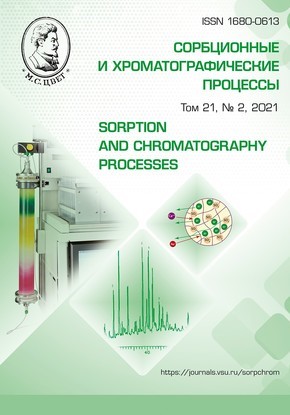Formal kinetic approach for the description of the kinetics of hydration of aluminosilicates
Abstract
The consideration of the peculiarities of water transport as the main component of a system is important when studying the kinetic characteristics of the sorption process with the participation of natural aluminosilicates, which are widely used as sorbents for active and auxiliary substances in pharmaceutical products. When studying the kinetic regularities of water adsorption by aluminosilicates, the problem of quantitative modelling of the process is of interest.
The objects of study were aluminosilicates: clinoptilolite from the Slovatsk deposit and glauconite from the south-west of the Voronezh anteclise, which are characterized by a crystalline structure and have the ability to perform ion exchange. The kinetics of water adsorption by aluminosilicates was studied by isopiesisation with water activity in vapour equal to 0.980 and a temperature of 295±2K. The amount of adsorbed water was determined by gravimetry. The kinetic study of the process of hydration of aluminosilicates included the experimental determination of the dependence of the amount of adsorbed water on time and mathematical processing of the data using kinetic equations based on specific models of solid-phase interaction.
It was revealed that a higher hydration capacity (by about 1.4 times) and an increase in the rate of reaching the equilibrium in the system of aluminosilicate - water molecules for clinoptilolite were due to a higher concentration of exchangeable cations and a more developed porosity and surface compared to weakly swelling glauconite.
The choice of the function g(α) corresponding to the mechanism at each stage of the hydration process was carried out by checking the linearity of the dependence log g (α) = τ for the considered equations describing the mechanism of water adsorption (α - the degree of reaching the equilibrium). From the equations, we chose the one that, in the given region α, corresponded to the minimum value of the dispersion. For each stage, limiting the process in a certain range of α, the kinetic characteristics were estimated using the dependence of log g (α) on τ.
It was found that at the initial stage, the hydration of aluminosilicates was controlled by the chemical stage. The rate of the process was determined by the formation of hydration centres. During this stage, clinoptilolite adsorbed 57%, and glauconite adsorbed 51% of the total amount of absorbed water. The adsorption of water during the second stage of the process was described by the reaction equation at the interface. Glauconite was characterized by a noticeable decrease in the rate of hydration during this stage, which was manifested in a significant decrease in its hydration capacity. During the final stage of hydration, diffusion restrictions appeared and the process was described by the equation of three-dimensional diffusion and it was characterized by a decrease in the overall rate of adsorption. Clinoptilolite was characterized by a later manifestation of diffusion restrictions, which was due to its structural characteristics.
Downloads
References
Boudissa F., Mirilà D., Arus A-V., Thizizi Terkmani et al., J. Hazard Mater., 2019, Vol. 364, pp. 356-366. DOI :10.1016/j.jhazmat.2018.09.070
Cerri Guido, Farina M., Brundu A., Daković A. et al., Microporous and Mesoporous Materials, 2016, Vol. 223, pp. 58-67. DOI: 10.1016/j.micromeso.2015.10.034
Novikova L., Belchinskaya L., Clays, Clay Minerals and Ceramic Materials Based on Clay Minerals, 2016, pp. 89-128. DOI: 10.5772/61678
Kotova D.L., Vasilyeva S.Y., Krysanova T.A., Khromova A.S. et al., Protection of Metals and Physical Chemistry of Surfaces, 2015, Vol. 51, No 4, pp. 499-504. DOI: 10.1134/S207020511504019X
Kotova D.L., Artamonova M.N., Krysanova T.A. Vasilenko M.S. et al., Pro-tection of Metals and Physical Chemistry of Surfaces, 2018, Vol. 54, No 4, pp. 598-602. DOI: 10.1134/S2070205118030073
Korkuna О., Leboda R., Skubiszewska-Zieba J., Microporous Mesoporous Mater., 2006, Vol. 87, pp. 243-254. DOI: 10.1016/j.micromeso.2005.08.002
Breck D. Zeolitjvye molekulyarnye sita, M., Mir. 1976. 760 p.
White D.A., Bussey R.L., Separ. Purif. Technol., 1997, Vol. 11, pp. 137-141.
Alver В.Е., Sakizci М., Yorukogullari Е., J. Therm. Anal. Calorim., 2010, Vol. 100, Iss.1, pp. 19-26. DOI: 10.1007/s10973-009-0118-0
Arcoya A., Gonzalez J., Llabre G., Seoane X.L. et al., Microporous Mesoporous Mater., 1996, Vol. 7, pp. 1-13. DOI: 10.1016/0927-6513(96)00022-3
Belchinskaya L.I., Khodosova N.A., Bityutskaya L.A., Physicochemistry of Sur-face and Protection of Materials, 2009, Vol. 45, No 2, pp. 218-221.
Belchinskaya L.I., Khodosova N.A., Strelnikova O.Yu., Petuhova G.A. et al., Physicochemistry of surfaces and protection of materials, 2015, Vol. 51, No 5, pp. 1-8. DOI: 10.7868/S0044185615050046
Novikova L, Belchinskaya L, Krupskaya V., Roessner F. et al., Sorptsionnye I khromatograficheskie protsessy, 2015, Vol. 15, No 5, pp. 730-740. DOI: 10.17308/sorpchrom.2015.15/327
Kirgintsev A.N. Essays on the thermo-dynamics of water-salt solutions. Novosi-birsk, Nauka, 1976, 201 p.
Cherenkova Yu.A., Kotova D.L., Sel-emenev V.F. et al., Journal of physical chemistry, 2005, Vol. 79, No 4, pp. 716-720.
Kowalczyk P., Myroslav S., Artur P.T., Journal of Colloid and Interface Science, 2006, Vol. 297, No 1, pp. 77-85. DOI: 10.1016 / j. jcis.2005.10.045
Sprynskyy M., Golembiewski R., Try-kowski G., Buszewski B., Journal of Phys-icsand Chemistry of Solids, 2010, Vol. 71, No 9, pp. 1269-1277. DOI:10.1016/j.jpcs.2010.05.006
Tretyakov Yu.D., Solid phase reac-tions, M., Chemistry, 1978, 172 p.
Channon Y.M., Catlow C.R.A., Jack-son R.A., Studies in Surface Science and Catalysis, 1995, Vol. 97, pp. 117-124. DOI: 10.1016/S0167-2991(06)81880-X
Borowski M., Wolf I., Gies H., Chem. Mater., 2002, No 14(1), pp. 38-43.
Delmont B., Kinetics of Heterogeneous Reactions, M ., Mir, 1972, 544 p.







